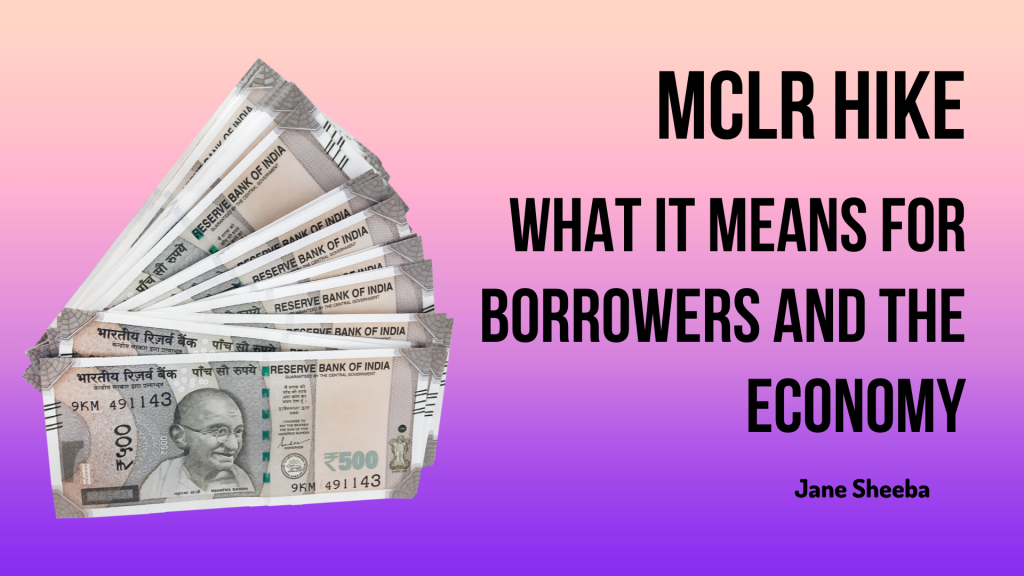
The State Bank of India (SBI), recently announced a potential increase in its marginal cost of funds-based lending rates (MCLR) by another 10-15 basis points (bps). This comes on the heels of a recent 10 bps hike implemented on June 15. The move signals that MCLR rates, which influence the cost of corporate loans, have not yet reached their peak. Here’s an in-depth look at what this means for borrowers and the broader economic landscape.
Understanding MCLR and Its Impact
What is MCLR?
The Marginal Cost of Funds-Based Lending Rate (MCLR) is a benchmark rate used by banks to determine the interest rates on various types of loans, primarily corporate loans. It reflects the bank’s cost of funds and is adjusted periodically based on several factors including changes in the policy repo rate, which is the rate at which the Reserve Bank of India (RBI) lends to commercial banks.
Impact on Corporate and Retail Loans
- Corporate Loans: These are directly impacted by changes in the MCLR. As the MCLR rises, the cost of borrowing for companies increases, potentially affecting their investment and expansion plans.
- Retail Loans: Retail loans such as home loans are usually linked to the External Benchmark Lending Rate (EBLR), which is often tied to the RBI’s policy repo rate. Therefore, these loans might not see an immediate impact from changes in the MCLR.
Reasons Behind the MCLR Hike
RBI’s Stance on Economic Conditions
The decision to hike the MCLR comes in the wake of guidance from RBI Governor Shaktikanta Das, who has urged banks to reassess their business models due to a persistent gap between credit and deposit growth rates. The central bank has maintained the repo rate at 6.5% since February 2023, influencing banks’ decisions regarding their lending and deposit rates.
Deposit Rate Transmission
A senior SBI executive, speaking to Business Standard, indicated that the transmission of higher deposit rates is nearly complete. Future adjustments will be specific to maturity buckets for asset-liability management. However, there is still room to adjust the lending side, where MCLR serves as the benchmark, by approximately 10-15 bps.
Tight Liquidity Conditions
Tight liquidity conditions have compelled banks to offer higher rates to attract depositors to meet the growing credit demand. This has, in turn, increased the cost of funds for banks, leading to higher MCLR.
Current MCLR Rates and Trends
As of June 15, the one-year MCLR, to which most loans are linked, stands at 8.75%. Despite peaking deposit rates, the effects on the lending side are expected to persist in the coming months. SBI Chairman Dinesh Khara has noted that while deposit rates have likely peaked, lending rates might continue to rise to stabilize net interest margins.
SBI’s Loan Portfolio
MCLR-linked credit comprises 36-37% of SBI’s loan book as of March 2024. For all scheduled commercial banks, MCLR-based credit accounts for 39.4% of total credit, according to RBI data.
Future Outlook and Market Sentiment
Industry and Services
The sentiment within industry and services is positive, with momentum gathering and capital expenditure opportunities increasing. Many enterprises are willing to pay slightly higher interest rates for loans, as indicated by an SBI executive.
Economic Reports and Trends
The RBI’s State of Economy report (May 2024) highlighted that in response to a 250 bps change in the policy repo rate since May 2022, the weighted average domestic term deposit rates on fresh and outstanding deposits increased by 259 bps and 185 bps, respectively. The one-year median MCLR rose by 166 bps from May 2022 to April 2024, reflecting the increased cost of funds.
Expert Opinions
Karan Gupta, head and director of financial institutions at India Ratings, remarked that the prospective MCLR hike is driven by ongoing upward pressure on the cost of funds due to deposit repricing. Gupta also noted that banks’ margins could be impacted if the RBI reduces the policy repo rate later in the financial year, as many retail loans are linked to external benchmarks.
Conclusion
The anticipated MCLR hike by SBI underscores the dynamic nature of interest rate adjustments in response to economic conditions and regulatory guidance. While corporate borrowers might face higher borrowing costs, the broader economic sentiment remains positive with robust activity in industry and services sectors. As the financial landscape evolves, both borrowers and lenders must stay attuned to these changes to navigate the implications effectively.







Leave a Reply